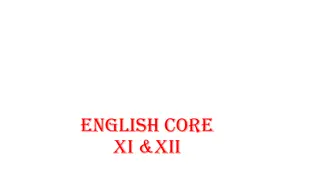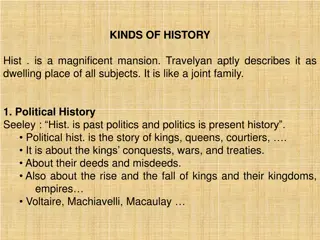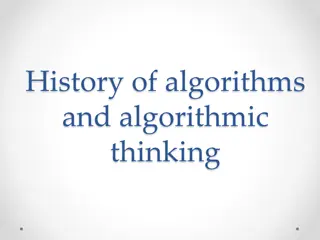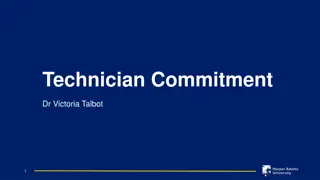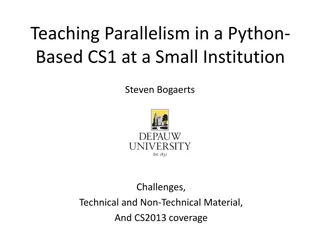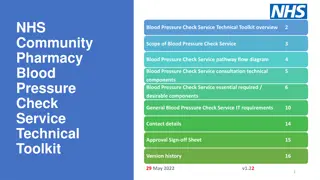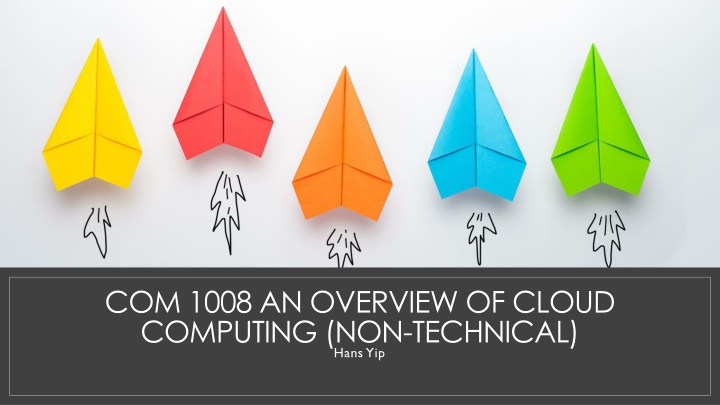
Evolution of Computers: A Non-Technical Overview from 1st to 3rd Generation
Explore the evolution of computers from the 1st to the 3rd generation, highlighting the advancements in technology, components used, and features of each era. From vacuum tubes to transistors to integrated circuits, witness the progression that revolutionized computing history.
Download Presentation

Please find below an Image/Link to download the presentation.
The content on the website is provided AS IS for your information and personal use only. It may not be sold, licensed, or shared on other websites without obtaining consent from the author. If you encounter any issues during the download, it is possible that the publisher has removed the file from their server.
You are allowed to download the files provided on this website for personal or commercial use, subject to the condition that they are used lawfully. All files are the property of their respective owners.
The content on the website is provided AS IS for your information and personal use only. It may not be sold, licensed, or shared on other websites without obtaining consent from the author.
E N D
Presentation Transcript
COM 1008 AN OVERVIEW OF CLOUD COMPUTING (NON-TECHNICAL) Hans Yip
Learning Objectives History and Development History of Computers (Generation of computers) Classification of Computers Thin client computing History of Thin Client Data centers Types of Data Centers
History of Computers 1stgeneration of computers (1946-1954): Limitations of 1stgeneration computer: 1. They used valves or vacuum tubes as their main electronic component. 2. They were large in size, slow in processing and had less storage capacity. 3. They consumed lots of electricity and produced lots of heat. 4. Their computing capabilities were limited. 5. They were not so accurate and reliable. 6. They used machine level language for programming. 7. They were very expensive. Example: IBM 650
FIRST GENERATION OF COMPUTERS
VACUUM TUBES
History of Computers 2ndgeneration of computers (1955-1964): (Mainframe and Supercomputer) Features: 1. Transistors were used instead of Vacuum Tube. 2. Processing speed is faster than 1stgeneration computers. 3. Smaller in Size (51 square feet). 4. They used high-level language such as Fortran, Cobol. 5. The input and output devices were faster. Example: IBM 1400 and 7000 Series
SECOND GENERATION OF COMPUTERS
History of Computers 3rdgeneration of computers (1964-1977) (Mainframe, Supercomputer, and Minicomputer) Features: 1. They used Integrated Circuit (IC) chips in place of the transistors. 2. Semi conductor memory devices were used. 3. The size was greatly reduced, the speed of processing was high, they were more accurate and reliable. 4. They were low cost, large memory and high processing speed. 5. Large Scale Integration (LSI) and Very Large Scale Integration (VLSI) were also developed. (ICs were replaced by LSI and VLSI). 6. The minicomputers were introduced in this generation. 7. They used high level language for programming such as BASIC (Beginners All purpose Symbolic Instruction Code). Example: IBM 360, IBM 370
THIRD GENERATION OF COMPUTERS
INTEGRATED CIRCUIT
History of Computers 4thgeneration of computers (1970) Microcomputer Features: 1. They used Microprocessor (VLSI) as their main switching element. 2. They are also called as microcomputers or personal computers. 3. Their size varies from desktop to laptop or palmtop. 4. They have very high speed of processing; they are 100% accurate, reliable, diligent and versatile. 5. They have very large storage capacity. 6. Operating System (O/S) MS-DOS, UNIX, and Apple s Macintosh were available. 7. They used high-level language such as C, C++ (Object Oriented language) Example: IBM PC, Apple-Macintosh etc.
FOURTH GENERATION OF COMPUTERS
APPLE COMPUTER
History of Computers 5thgeneration of computers (1991 continued) tablet, smartphone Fifth Generation of computers use ULSI (Ultra-Large Scale Integration) chips. Millions of transistors are placed in a single IC in ULSI chips. 64 bit microprocessors have been developed during this period. Memory chips and flash memory up to 1 GB, hard disks up to 600 GB & optical disks up to 50 GB have been developed. Fifth Generation digital computer will beArtificial intelligence.
FIFTH GENERATION OF COMPUTERS
ARTIFICIAL INTELLIGENCE
Classification of Computers Supercomputer has internally large storage capacity and computing speed. Which are at least Ten Times faster than other computer. It can process trillions of instructions per second. Supercomputer are the largest, Fastest and Expensive Computer System in the world. It can be used for weather forecasting, and automobile designing. Famous Supercomputers are IBM Sequoia (for research by NASA) CRAY-2
Classification of Computers Mainframe: A computer with a large storage capacity and very fast speed of processing compare to Micro or Minicomputer. They Support a large numbers of terminals for used by a verity of users. (support a large numbers of users at the same time) They are used by large organizations such as Bank,Insurance Company, Hospital and Railway The Main Characteristic of Mainframe Computers Many people can be used the machine at the same time. Qualified operator and programmer are required for operation. Support a wide range of peripherals & Have a large storage capacity. Example: IBM zSeries
Classification of Computers A Minicomputer (midrange computer) is a medium size i.e. more costly and powerful then a Microcomputer. Minicomputer is usually design to serve multiples users. A system that support multiples users is also called Time Sharing system. Minicomputer is less efficient and store less data then the Mainframe Computer. The Main Characteristic of Minicomputers are:- Have a limited range of peripherals device. Limited software is used. Can be directly operated by the users. Example: PDP-7
Classification of Computers A Microcomputer is smaller to any other large systems. Microcomputer is the self contain units and usually design for used by one person at a time. Microcomputer is also called a personal computer (PC), and is a device based on a single- chip microprocessor. The common Characteristics of Microcomputers are:- Cheap and easy for use. Have a limit input and output device. Have a low storage capacity. Limited range of software can be use. Note: Common microcomputers include desktops, laptops/notebooks, tablets, smartphones, and calculators (embedded systems)
What is Thin Client? Thin clients are computer terminals or software programs that rely on an external computer to perform work. The thin client accepts inputs into the system and displays the results of those inputs on its screen; the actual computations are performed on a distant server. Thin clients perform much like the dumb" serial terminals of the past, only now thin clients run as clients of Windows or other operating systems.
THIN CLIENT
Thin Client History Thin client was the description of a computer terminal popularized by Oracle beginning in 1993. Because Oracle is server-oriented software, clients do not require much in the way of computing power. Significant savings could be realized with Oracle over other models such as Microsoft s that focused on computational power residing on the desktop. Although the term, "thin client", began in the 1990s,thin client history dates back way before then. Known as "dumb terminals", the early thin clients were first used to interface with mainframe computers. Serial connections with the mainframe were used to send keystrokes to it and to display the results. All the programming and data were stored on the mainframe, with virtually no computational power residing with the terminal itself.
Thin Client History The advent of the PC in the 1980s and the decreased cost of computational power resulted in a new emphasis on localized, rather than centralized processing. This emphasis required operating systems and software to be installed and maintained on each individual computer. This sacrificed the centralized administration, security, and programming of the mainframe/dumb terminal configuration, ushering in the host of issues many deal with today. Modern IT has come full circle. By provisioning centralized data security, backups and network / system administration, thin clients offer considerable flexibility and cost savings over traditional PC networks, while making it easier to monitor employee use of network resources. High speed networks enable thin clients to access Windows applications as fast as they would run on a local machine.
Thin Client History Thin clients can now come in different forms. Besides a traditional computer terminal, wireless thin clients are now deployed for use on LANs and cellular networks. Thin clients can also run as software on a networked PC. Ultra-thin clients expand on the thin client concept, but take it a step further by eliminating the need for a full operating system. An ultra-thin client comes equipped with a basic operating environment that allows configures the network and display options for the unit.
What is a Data Center? At its simplest, a data center is a physical facility that organizations use to house their critical applications and data. A data center's design is based on a network of computing and storage resources that enable the delivery of shared applications and data.
What defines a modern data center? Modern data centers are very different than they were just a short time ago. Infrastructure has shifted from traditional on-premises physical servers to virtualized infrastructure that supports applications and workloads across pools of physical infrastructure and into a multi-cloud environment. In this era, the modern data center is wherever its data and applications are. It stretches across multiple public and private clouds to the edge of the network via mobile devices and embedded computing. In this constantly shifting environment, the data center must reflect the intentions of users and applications.
What are the core components of a data center? Data center design includes routers, switches, firewalls, storage systems, servers, and application delivery controllers. Because these components store and manage business-critical data and applications,data center security is critical in data center design. Together, they provide: Network infrastructure.This connects servers (physical and virtualized), data center services, storage, and external connectivity to end-user locations. Storage infrastructure. Data is the fuel of the modern data center. Storage systems are used to hold this valuable commodity. Computing resources.Applications are the engines of a data center. These servers provide the processing, memory, local storage, and network connectivity that drive applications.
Types of data centers Many types of data centers and service models are available. Their classification depends on whether they are owned by one or many organizations, how they fit (if they fit) into the topology of other data centers, what technologies they use for computing and storage, and even their energy efficiency. There are four main types of data centers: 1. Enterprise data centers: These are built, owned, and operated by companies and are optimized for their end users. Most often they are housed on the corporate campus. 2. Managed services data centers: These data centers are managed by a third party (or a managed services provider) on behalf of a company. The company leases the equipment and infrastructure instead of buying it. 3. Co-location data centers: In co-location ("colo") data centers, a company rents space within a data center owned by others and located off company premises. The co-location data center hosts the infrastructure-- building, cooling, bandwidth, physical security, etc. while the company provides and manages the components, including servers, storage, and firewalls. 4. Cloud data centers: In this off-premises form of data center, data and applications are hosted by a cloud services provider such as Amazon Web Services (AWS), Microsoft (Azure), or IBM Cloud. NOTE: Discover more about data centers and what the future will bring to them and your network.
Summary of IT Technologies 1960, Mainframe, Super-computer, punch card type-writer, punch card reader, dumb terminal. e.g. IBM System/360, CRAY 1970, Mini-computer (mid range computer), personal computer, Apple computer 1980, Client server architecture, Networking, server, workstation 1990, Internet, web 2000, cell phone, cloud computing, big data, thin client 2010, tablet, smartphone
Questions What are the five generations of computer, and what are the features? What are the types of computer? What is thin client? What is data center, and what are the types of data centers?
References https://www.computerhope.com/issues/ch001921.htm https://homepage.cs.uri.edu/faculty/wolfe/book/Readings/Reading03.htm https://www.computerhistory.org/timeline/computers/ https://www.livescience.com/20718-computer-history.html https://www.suse.com/c/mainframe-gnulinux-thin-client-advantages-methodology/ https://www.brighthub.com/environment/green-computing/articles/71173.aspx https://www.quora.com/What-are-the-different-types-of-computers http://ecomputernotes.com/fundamental/introduction-to-computer/minicomputer https://www.cisco.com/c/en/us/solutions/data-center-virtualization/what-is-a-data-center.html










